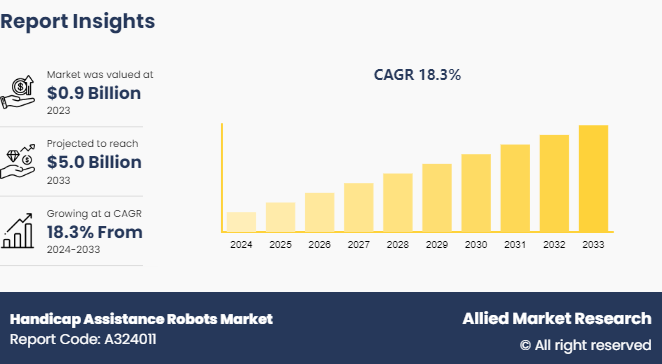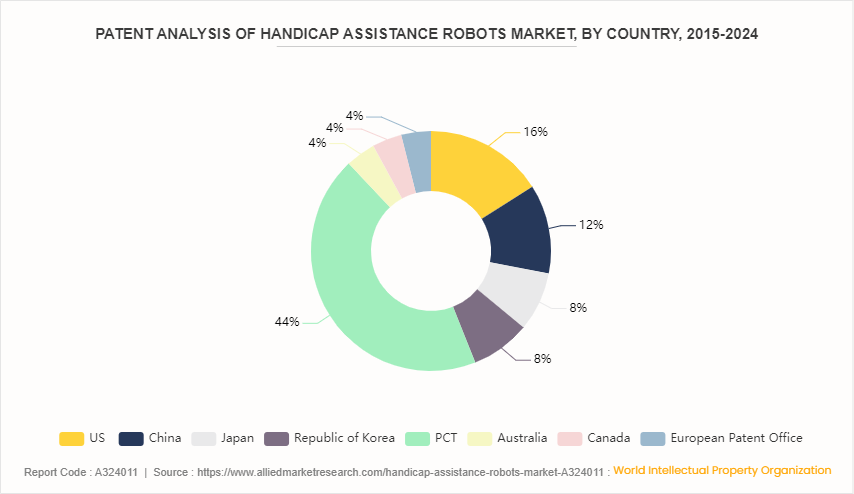Handicap Assistance Robots Market Research, 2033
The global handicap assistance robots market size was valued at $0.9 billion in 2023, and is projected to reach $5.0 billion by 2033, growing at a CAGR of 18.3% from 2024 to 2033. The handicap assistance robots market is driven by the growing aging population, increasing prevalence of disabilities, advancements in robotics technology, and rising demand for improved quality of life and independent living solutions for individuals with mobility challenges.

Market Introduction and Definition
Handicap assistance robots are advanced devices designed to support individuals with disabilities or mobility impairments. These robots aim to enhance the quality of life by providing physical assistance, improving mobility, and facilitating daily activities. They can perform a variety of tasks, such as helping with personal care, navigating physical spaces, or handling household chores.
Handicap assistance robots are often equipped with sophisticated sensors, artificial intelligence, and adaptive technologies that allow them to interact seamlessly with their users and adapt to their specific needs. By integrating these robots into daily routines, individuals with disabilities can achieve greater independence and participate more fully in their personal and social lives.
Key Takeaways
- The handicap assistance robots industry study covers 20 countries. The research includes a segment analysis of each country in terms of value ($Billion) for the projected period 2023-2033.
- More than 1, 500 product literatures, industry releases, annual reports, and other such documents of major handicap assistance robots market industry participants along with authentic industry journals, trade associations' releases, and government websites have been reviewed for generating high-value industry insights.
- The study integrated high-quality data, professional opinions and analysis, and critical independent perspectives. The research approach is intended to provide a balanced view of global markets and to assist stakeholders in making educated decisions in order to achieve their most ambitious growth objectives.
Key Market Dynamics
The handicap assistance robots market size is primarily driven by the rising aging population and the increasing prevalence of disabilities and chronic conditions that necessitate assistive technologies. Advances in robotics and AI have made these robots more efficient and user-friendly, further boosting their adoption. For example, robotic exoskeletons, like those from companies such as ReWalk Robotics, have significantly improved mobility for individuals with spinal cord injuries, enhancing their quality of life. Government initiatives and funding for assistive technology also play a crucial role in handicap assistance robots market growth, as seen with policies supporting disability aids in countries such as the U.S. and Japan.
However, the market faces significant restraints during handicap assistance robots market forecast, including the high costs of these advanced robotic systems, which can be prohibitive for many potential users. Additionally, there is a lack of awareness and acceptance of robotic assistance among some elderly and disabled individuals, who may prefer traditional caregiving methods. Technical challenges, such as ensuring the reliability and safety of these robots in diverse environments, also pose hurdles.
Despite these challenges, the market presents substantial handicap assistance robots market opportunity. Ongoing technological innovations, such as the integration of AI for better user interaction and machine learning for improved adaptability, are expected to make these robots more accessible and effective. Collaborations between tech companies and healthcare providers can lead to the development of more tailored solutions, as seen with partnerships like Toyota’s work with the Massachusetts Institute of Technology to create robots that assist with daily activities. The growing trend of smart homes and IoT can also facilitate the seamless integration of handicap assistance robots, expanding their utility and appeal.
Market Segmentation
The handicap assistance robots industry is segmented into product, type, and region. On the basis of product, the market is bifurcated into robotic parts and robotic wheelchair. Based on type, the market is divided into stationary and mobility. Region wise, the market is analyzed across North America, Europe, Asia-Pacific, and LAMEA.
Regional/Country Market Outlook
North America has the largest handicap assistance robots market share is driven by several key factors. Firstly, the aging population in the region is increasing the demand for advanced assistive technologies to aid elderly individuals with mobility and daily activities. Technological advancements in robotics and artificial intelligence are enhancing the capabilities of these robots, making them more efficient and user-friendly.
Additionally, the growing awareness and acceptance of robotic solutions for disability assistance among both patients and healthcare providers are fostering market growth. Government initiatives and funding for healthcare innovation, along with favorable insurance policies, are also supporting the adoption of handicap assistance robots. Moreover, the rising prevalence of chronic diseases and disabilities, coupled with the need for improved quality of life for individuals with physical impairments, is further propelling market expansion.
Industry Trends
- The industry is witnessing rapid technological advancements, including the integration of AI, machine learning, and advanced sensors. These innovations enhance the robots' ability to interact with and adapt to their users' needs, making them more effective and user-friendly.
- As the global population ages and the prevalence of disabilities increases, there is a growing demand for assistive technologies. Handicap assistance robots are becoming increasingly popular in healthcare and home care settings.
Patent Analysis, By Country, 2015-2024
PCT witnessed the highest number of patent approvals and applications, due to favorable government policies, new technological advancement and new product launches in the country. U.S. has 16.0% of the total number of patents, followed by the China at 12.0%.

Competitive Landscape
The major handicap assistance robots market share players operating in the handicap assistance robots market include Aether Biomedical sp. z o.o., Assistive Innovations BV, Bionik Laboratories Corp., COVVI, Cyberdyne Inc., Ekso Bionics Holdings Inc., Focal Meditech, GOGOA Mobility-Robots SL, Honda Motor Co. Ltd., Japet Medical Devices, and Kinova Inc. Other players in the handicap assistance robots market include Ossur hf, Ottobock SE and Co. KGaA, Panasonic Holdings Corp., ReWalk Robotics Ltd., Rex Bionics Ltd., Toyota Motor Corp., Trexo Robotics Inc., Wandercraft, and Bionic Yantra., and so on.
Recent Key Strategies and Developments
- In December 2022, Ekso Bionics announced acquisition of Human Motion and Control Business unit including Indego product line from Parker Hannifin Corporation.
- In October 2022, Medtronic plc, a global healthcare technology leader, announced three significant global market-entrance and indication expansion approvals for its Hugo robotic-assisted surgery (RAS) system.
- In August 2022, Intuitive Surgical Inc, the U.S.-based robotic surgical system manufacturer, was investing over 700 million yuan ($103.7 million) to build a manufacturing and innovation base in Shanghai to expand access to robotic assisted surgery to more patients in China.
- In January 2019, Honda announced that it has received Premarket Notification from the U.S. Food and Drug Administration (FDA) for its Walking Assist Device, an externally worn device developed to support people with reduced walking abilities. June 2019, ReWalk Robotics, Inc., a developer of wearable robotic exoskeletons, based in the U.S., announced that the Food and Drug Administration (FDA) approved ReStore soft exo-suit system for sale to the rehabilitation centers in the U.S. The system will be used to treat stroke survivors with mobility challenges.
Key Benefits For Stakeholders
- This report provides a quantitative analysis of the handicap assistance robots market segments, current trends, estimations, and dynamics of the handicap assistance robots market analysis to identify the prevailing market opportunities.
- The market research is offered along with information related to key drivers, restraints, and opportunities.
- Porter's five forces analysis highlights the potency of buyers and suppliers to enable stakeholders make profit-oriented business decisions and strengthen their supplier-buyer network.
- In-depth analysis of the handicap assistance robots market segmentation assists to determine the prevailing market opportunities.
- Major countries in each region are mapped according to their revenue contribution to the global handicap assistance robots market statistics.
- Market player positioning facilitates benchmarking and provides a clear understanding of the present position of the market players.
- The report includes the analysis of the regional as well as global handicap assistance robots market trends, key players, market segments, application areas, and market growth strategies.
Key Sources Referred
- Centers for Disease Control and Prevention
- World Health Organization
- National Center for Biotechnology Information
- The Lancet
- Australian Bureau of Statistics
- Science Direct
- Health Resources and Services Administration (HRSA)
- Department of Health and Human Services (HHS)
- National Institutes of Health (NIH)
- GOV.UK
Handicap Assistance Robots Market Report Highlights
| Aspects | Details |
| Market Size By 2033 | USD 5.0 Billion |
| Growth Rate | CAGR of 18.3% |
| Forecast period | 2024 - 2033 |
| Report Pages | 260 |
| By Product |
|
| By Type |
|
| By Region |
|
| Key Market Players | Assistive Innovations BV, CYBERDYNE INC., GOGOA Mobility-Robots SL, Aether Biomedical sp. z o.o., COVVI, Honda Motor Co. Ltd, Bionik Laboratories Corporation, Focal Meditech B.V., Ekso Bionics Holdings Inc, Japet Medical Devices |
The Aether Biomedical sp. z o.o., Assistive Innovations bv, Bionik Laboratories Corp., COVVI, Cyberdyne Inc., Ekso Bionics Holdings Inc. held a high market position in 2023.
The base year is 2023 in handicap assistance robots market.
The forecast period for handicap assistance robots market is 2024 to 2033.
The market value of handicap assistance robots market is projected to reach $5 billion by 2033.
The total market value of handicap assistance robots market was $0.9 billion in 2023.
Loading Table Of Content...



